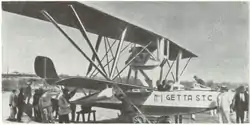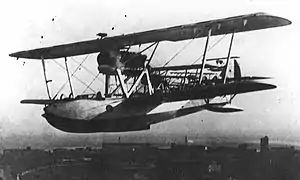The Romanian Naval Aviation was the air arm of the Royal Romanian Navy. It was founded in 1920 as Escadrila de hydroplane (Seaplane Squadron) and operated Hansa-Brandenburg W.29 floatplanes and Hansa-Brandenburg FB flying boats. These were followed by native-built aircraft and imports from Italy (flying boats) and Germany (floatplanes), resulting, by the time of the Second World War, in a sizable and active force of over 70 watercraft. Currently the Romanian Naval Aviation consists of Grupul 256 Elicoptere (256th Helicopter Group) equipped with IAR 330 Naval helicopters.
History

The first Romanian seaplane squadron was founded in 1920 by Royal Decree no. 2256 bis, from 15 May 1920, under the command of Captain Constantin Negru. It was named Escadrila de hydroplane and consisted of 12 Hansa-Brandenburg W.29 floatplanes and Hansa-Brandenburg FB flying boats.[1][2] In 1925 four native-built RAS-1 Getta training flying boats were added.[3][4] In 1921, the base of the naval aviation was moved to a new base on Lake Siutghiol.[2] By 1928, the Grupul de Hidroaviație (Hydroaviation Group) had 3 squadrons. In 1930, Flotila de Hidroaviație (the Seaplane Flotilla) was established. In the years 1932-1933, at Palazu Mare, a modern seaplane base was built. It was fully equipped with installations and boats for maneuvering seaplanes and for rescuing the crews and seaplanes damaged in case of accident.[1]
The first Romanian-made floatplanes were versions of the SET 7 biplane, a total of eight being were built for the Romanian Naval Aviation.[5]
Operational history in World War II
In 1941, the Comandamentul Aero Dobrogea (Dobrogea Aero Command) was established, including the Seaplane Flotilla and the 53rd Fighter Squadron. On 26 March 1942, its name was changed to Comandamentul Aero Marină (Marine Aero Command).[1] The aircraft and their crews proved their worth in reconnaissance missions along the coast and offshore to the Crimean coast, in the northern Black Sea basin or on the coasts of Asia Minor, as well as in anti-submarine and convoy escort missions.[1]
The most notable achievements of the Romanian Naval Aviation during World War II were the sinking of two Soviet submarines by a single Z.501 in August 1941, followed by the capture of a Soviet armed merchantman by a group of Heinkels in October. Romanian seaplanes monitored Soviet Navy locations and movements for the Luftwaffe bombers, which, with assistance from Escadrila 102, extirpated Soviet submarines from the Black Sea by late-autumn 1941.[6]
A slight defeat came in the autumn of 1943, when a Z.501 was shot down by Soviet ace Grigoriy Rechkalov.[7] Throughout the war, Romania lost 8 seaplanes, of which 7 were due to accidents.[1]
On 8 September 1944, the Seaplane Flotilla, its headquarters and bases were occupied by Soviet troops. Material goods and the operational archive of the Flotilla were confiscated. After the war, the period of decline continued.[1]
Italian flying boats
Before the war, Romania acquired seven Savoia-Marchetti S.55 double-hulled flying boats as well as eleven Savoia-Marchetti SM.62 biplane flying boats.[8] Five of the latter were licence-built locally at the IAR factory in Brașov.[9][10][11] In 1941, twelve CANT Z.501 were also purchased.[12] The twelve Z.501s formed Escadrila 101, with more acquired later for Escadrila 102, which also possessed an unspecified number of Savoia-Marchetti S.56.[13] An unspecified amount of Savoia-Marchetti S.59 was also acquired before the war.[14]
German floatplanes
For training purposes, three Heinkel He 42 were purchased.[15] During the war, 34 Heinkel He 114 were also acquired,[16] followed by an unspecified amount of Arado Ar 196 during the war.[17]
Post-war
The Flotilla was disbanded, and in the organization chart of the Air Force Command of 1950 there was only one seaplane squadron left. On 1 April 1960, what was left of the flotilla, Patrula 256 Hidroaviație (256th Hydroaviation Patrol), was disbanded.[1]
In an article published in Revista Marinei, no. 4-5/April-May 1948, Captain Dan Nicolaescu tried to draw the attention of decision makers to the importance of naval aviation, where he said that: "A navy, no matter how small, cannot do without its aviation, without the sanction of being in a clear state of inferiority to any enemy. Maritime information aviation is an integral part of the navy, an indispensable part, which forms the sailor's eye of which he cannot do without."[1]
In 1978, the 59th Helicopter Squadron, later Helicopter Regiment, was established. It was deployed at Tuzla Airfield and was an aviation unit which, although not subordinate to the command structures of the Navy, it operationally met important criteria defining a maritime aviation structure: it was located in the immediate vicinity of the Black Sea coast and halfway between the main military ports of Constanța and Mangalia, had helicopters equipped with special equipment for flying over the sea and its missions were carried out mainly in cooperation and support of sea and river ship units.[1]
Modern day

An important moment is the entry into the service of the navy of the cruiser Muntenia, the largest military ship ever built in Romania. Desired to be classified as a helicopter carrier, the designers and builders adopted a series of technical solutions to meet this operational requirement. The ship was fitted with an appropriately sized flight deck and hangar, which was scheduled to house an IAR 330L helicopter, however, the installations and equipment necessary for the embarkation and operation of a helicopter on board the ship had not been carried out at a sufficient technical level. The helicopter carrier capability requirements were reported to be met, but no operational helicopter testing was performed on board, and cooperation with aviation specialists was insufficient.[1]
Things changed radically with Romania's accession to the Partnership for Peace and the desire of joining NATO. In this context, the frigate Mărășești (former Muntenia) participated for the first time in a multinational naval exercise led by NATO in the Atlantic Ocean. During the exercise an IAR 316 B helicopter no. 49 and a detachment belonging to 59th Helicopter Group Tuzla, led by the unit's commander, Paul Constantinescu was embarked on the frigate.[1] The lack of proper helicopter-carrying capabilities and especially the lack of ship stabilization equipment, coupled with adverse weather resulted in only two flights over the Mediterranean and one over Atlantic. Even in these conditions, this event remains an important milestone in the reaffirmation of naval aviation in Romania.[1]
With the acquisition of the two Type 22 frigates (Regele Ferdinand and Regina Maria), there was a need to purchase helicopters capable of operating on board the frigates.[1] On 1 May 2006, based on the Order no. MS 28 of 20 February 2006 and on Order no. B5/S/966 of 26 April 2006, Grupul 256 Elicoptere (256th Helicopter Group) from Flotila 56 Fregate (56th Frigate Flotilla) operating the IAR 330 Puma Naval was established.[1]
Missions
The on-board helicopters are currently used for the following missions:[18]
- ASW (Anti-Submarine Warfare) - detection, classification, identification of submarine targets, determination of evolutionary elements and attack of submarines;
- ASuW (Anti-Surface Warfare) - detecting, determining the evolutionary elements of surface targets and classifying them;
- SAR (Search and rescue) - in the lagoon and maritime area;
- Maritime surveillance;
- Logistical support - transport of people, materials, VERTREP, CASEVAC/MEDEVAC;
- Anti-piracy/anti-terrorism operations - insertion / extraction and support of Special Operations Forces.
List of aircraft
Flying boats
| Name | Picture | Origin | Quantity | Note |
|---|---|---|---|---|
| Hansa-Brandenburg FB |  |
4 | First Romanian flying boats. Captured during the war of 1919, used until 1922.[19] | |
| RAS-1 Getta |  |
4 | First Romanian-made flying boats, unarmed In service 1926–1932[19] | |
| Savoia-Marchetti S.55 |  |
7 | Double-hulled In service 1933–1942[20] | |
| Savoia-Marchetti S.56 |  |
6 | Biplane, unarmed In service 1932–1943[21] | |
| Savoia-Marchetti S.59 |  |
9 | Biplane bomber, one 7.7 mm machine gun In service 1928–1942[22] | |
| Savoia-Marchetti SM.62 |  |
15 | Five licence-built locally; biplane bomber, four 7.7 mm machine guns In service 1932–1945[23] | |
| CANT Z.501 |  |
12 | Largest Romanian flying boats; monoplane bomber, two or three 7.7 mm machine guns In service 1940–1945[24] |
Floatplanes
| Name | Picture | Origin | Quantity | Note |
|---|---|---|---|---|
| Hansa-Brandenburg W.29 |  |
12 | First floatplanes used by Romania. UFAG-made aircraft captured during the war of 1919, used until 1922.[25][2] | |
| SET 7H |  |
8 | First Romanian-made floatplanes | |
| Heinkel He 42 |  |
3 | Used for training In service 1943–1946[16] | |
| Heinkel He 114 |  |
34[16] | Light bomber & reconnaissance In service 1942–1960 | |
| Arado Ar 196 |  |
2 | Light bomber & reconnaissance, two 7.92 mm machine guns and two 20 mm cannons. Two Ar 196A-3 were used by the Seaplane Flotilla and deployed at Odessa in 1943.[26] |
Helicopters
| Name | Picture | Origin | Quantity | Note |
|---|---|---|---|---|
| IAR 330 Naval | .jpg.webp) |
3 | In service |
References
- 1 2 3 Cornel Năstase (2004). "Hansa Brandenburg W.29". Modelism 2004-02 (in Romanian). p. 6.
- ↑ Ion Gudju; Gheroghe Iacobescu; Ovidiu Ionescu (1974). Romanian Aeronautical Constructions 1905-1974 (PDF). p. 104.
- ↑ Romanian Review, Volume 36, Issues 8-12. Europolis Pub. 1982. p. 31.
- ↑ "SET 7". airwar.ru (in Russian).
- ↑ Frank Joseph, The Axis Air Forces: Flying in Support of the German Luftwaffe, ABC-CLIO, 2011, p. 166
- ↑ George Mellinger, Soviet Lend-Lease Fighter Aces of World War 2, Bloomsbury Publishing, 2012, p. 72
- ↑ Spencer C. Tucker, World War II at Sea: An Encyclopedia (2 volumes): An Encyclopedia, ABC-CLIO, 2011, p. 633
- ↑ Mark Axworthy, London: Arms and Armour, 1995, Third Axis, Fourth Ally: Romanian Armed Forces in the European War, 1941–1945, p. 272
- ↑ Francesco Sorge, Giuseppe Genchi, Essays on the History of Mechanical Engineering, Springer, 2015, p. 144
- ↑ Anthony Robinson (1979). The Illustrated encyclopedia of aviation, Volume 11. Marshall Cavendish Corp. p. 11. ISBN 978-0-85685-318-0.
- ↑ Hans Werner Neulen, In the Skies of Europe: Air Forces Allied to the Luftwaffe 1939-1945, Crowood, 2000, p. 92
- ↑ Ronald L. Tarnstrom, Balkan Battles, Trogen Books, 1998, p. 357
- ↑ David W. Wragg, Jane's Air Forces of the World: The History and Composition of the World's Air Forces, Collins, 2003, p. 152
- ↑ Cristian Crăciunoiu, Jean-Louis Roba, Aeronautica română în al doilea război mondial, Modelism, 2003, p. 259 (contains translations in English)
- 1 2 3 Antoniu 2014, p. 218.
- ↑ Frank Joseph, The Axis Air Forces: Flying in Support of the German Luftwaffe, ABC-CLIO, 2011, pp. 165-166
- ↑ "MISIUNI". navy.ro (in Romanian).
- 1 2 Antoniu 2014, p. 59.
- ↑ Antoniu 2014, p. 118.
- ↑ Antoniu 2014, p. 114.
- ↑ Antoniu 2014, p. 93.
- ↑ Antoniu 2014, p. 115.
- ↑ Antoniu 2014, p. 194.
- ↑ Antoniu 2014, p. 60.
- ↑ Enciclopedia Ilustrada De La Aviacion Tomo 02 (in Spanish). 1982.
Bibliography
- Antoniu, Dan (2014). Illustrated History of Romanian Aeronautics. ISBN 978-973-0-17209-6.